The yellow tulip is a beloved bloom that symbolizes joy, happiness, and sunshine. Its distinct hue has been associated with more positive emotions than any other flower color throughout history, making it an ideal gift for expressing one’s gratitude and appreciation.
The shape of this flower is delicate yet eye-catching which adds to its appeal. Arranging yellow tulips in bouquets or vases accentuates their beauty and makes them the perfect addition to any home or garden. The vibrant hue of the yellow tulip speaks volumes about its symbolism. This cheerful bloom also reminds us to embrace new beginnings and hopefulness during cold winter months.
Different Varieties of Yellow Tulips
Ballerina Tulip:
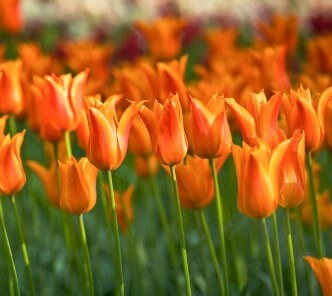
The Ballerina tulip has a soft, buttercup-yellow hue and an elegant cup form that is slightly pointed at the end. These blooms have long stems with delicate petals that make them appear as if they are dancing in the wind!
Lemon Gem Tulip:
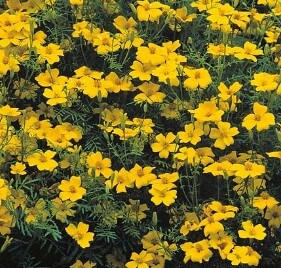
This classic yellow variety has a unique star-like shape and sweet aroma that make it stand out. Its petals are vibrant yellow in color and have an open shape, giving its blooms a unique and cheerful look. Its pointed center makes its flowers distinct from other varieties of tulips.
Daydream Tulip:
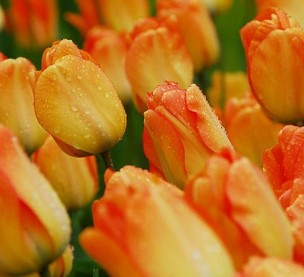
The Daydream tulip features soft yellow blooms streaked with lighter tones that offer a dreamy, romantic appearance. These flowers have excellent vase life which means they will hold up in arrangements much longer than standard varieties!
Golden Agent Tulip:
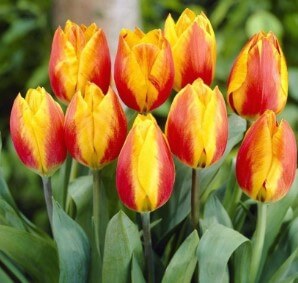
A beautiful medium-tall variety featuring double, star-shaped flowers in golden yellow all over the globe shaped cups of this bloom making it one of the most eye catching choices when creating special arrangements or centerpiece bouquets.
Little Princess Tulip:
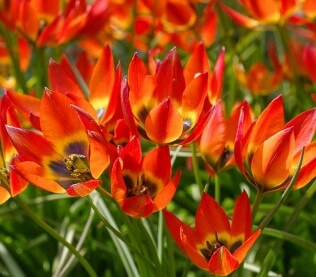
Little Princess is characterized by its bright yellow petals and double-flowered appearance. It has a creamy hue at its center that adds an elegant touch to the flower. The unique shape of this tulip enhances its delicate beauty, making it perfect for expressing love or gratitude in bouquets or displays.
Big Smile Tulip:
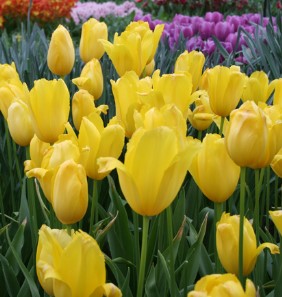
This hybrid is full of vibrant yellows, oranges, and reds that create a beautiful splash of color wherever it is placed! The uneven petal length gives Big Smile an extra sparkle making them perfect for adding brightness to your home or special occasions!
Golden Parade Tulip:
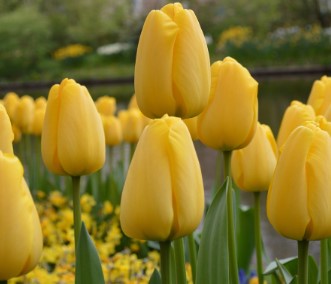
Named after its high stature, the Golden Parade offers eye catching displays boasting smooth satin-like petals in golden tones throughout each bloom giving off a certain sophistication to any arrangement or celebration!
Yellow Rosy Edged Tulip:
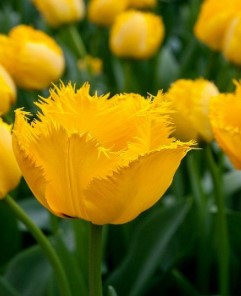
This classic double-flowered tulip features golden petals with intricate rosy pink stripes around their edges in order to stand out among other varieties of tulips! With just enough subtlety yet eye-catching detail, these beauties are sure to make any garden or bouquet breathe life into the surrounding area!
Yellow Flag Tulip:
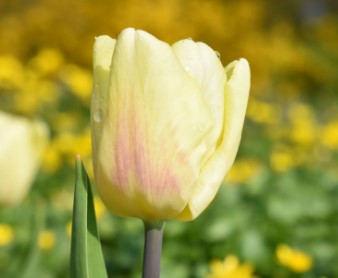
Yellow Flag is known for its large cupped petals ranging in various shades of yellows along with stunning tall stems that reach high above other varieties of tulips when fully bloomed! Perfect for adding some height to your garden, this fresh beauty offers elegance as well as showiness in any floral arrangement!
Tango Tulip:
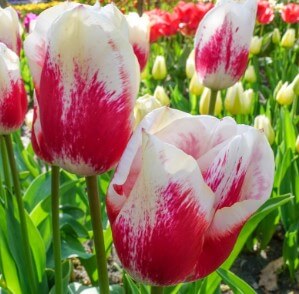
A favorite amongst many due to its cheerful buttercream hue and unparalleled gracefulness; these blooms provide a lighthearted look essential for sunny days filled with celebrations like weddings or even birthdays!
How to Grow for Yellow Tulips
Select Location
Select a location that gets at least 6 hours of direct sunlight each day and has good soil drainage. Dig an 8-12 inch (20-30 cm) deep hole in the chosen area and use compost or mulch to improve soil nutrition.
Planting
Plant bulbs at least 2 inches (5 cm) deep and make sure the pointed end is facing up. Fill the hole with soil making sure the bulb is securely covered and gently press down to firm the surroundings.
Water the newly planted bulbs lightly, making sure not to over water them as tulips are susceptible to rot.
Regular Watering
Follow a regular watering schedule throughout the growing season, keeping in mind that tulips generally do not require excessive amounts of water—just enough to keep the soil slightly moist.
When blooms begin to wilt, cut them off at their base using sterilized scissors as this will help promote healthier new blooms for next year’s flower show!
Common Problems with Yellow Tulips
Pest Infestation
Pest infestation can cause wilted leaves, stunted growth, discolored petals or leaves and an irregular blooming cycle. Common pests that may affect yellow tulips include aphids, thrips, whiteflies, leafhoppers and caterpillars. These insects feed on the plant’s foliage and stems which can weaken and damage the plant significantly.
Nutrient Deficiencies
Nutrient deficiencies in yellow tulips can lead to stunted growth, discoloration of petals or leaves, yellowed foliage and reduced blooms. Insufficient nitrogen, phosphorus and potassium are common nutrient deficiencies that can harm a yellow tulip.
Environmental Stressors
Environmental stressors can harm a yellow tulip, leading to discolored petals or leaves, wilted foliage and stunted growth. Temperature extremes, either too hot or too cold, can weaken the plant’s health significantly. Low humidity levels as well as lack of sunlight cause yellow tulips to be weak and appear pale.
Pathogenic Fungi and Bacteria
Pathogenic fungi and bacteria can damage yellow tulips and cause the plants to become stunted or blotchy. Fungi such as Botrytis cinerea, Rusts and Powdery mildews are some of the most common pathogens that attack yellow tulips. Bacteria such as Xanthomonas campestris pv. vasculorum can also affect the growth of these flowers.
Improper Planting
Improper planting of yellow tulips can lead to a number of problems that affect the health and appearance of the plant. Planting too deeply or too shallowly can cause the roots to become stunted, leading to poor growth and spindly stems. Poor soil drainage can make the soil waterlogged, causing the plants to rot and die.
Tips for Preventing Problems with Yellow Tulips
- Choose a location that receives direct sun for at least 6 hours a day and is sheltered from windy areas or extreme temperatures.
- Avoid planting too deeply or too shallowly by measuring the depth of the hole before you plant.
- Make sure soil has adequate drainage and is not waterlogged. If necessary, add a few inches of gravel to the bottom of the planting area to ensure good drainage.
- Use nutrient-rich compost or mulch when planting to provide necessary nutrition for healthy growth.
- Wear gloves when handling plants and avoid touching them with your hands as this increases risk of transmitting bacteria or infection from one plant to another.
Conclusion
Growing yellow tulips is a rewarding experience. With proper soil and sunlight, the brilliant blooms can be enjoyed for many years to come. Be sure to select a location with ample sunlight, good drainage and nutrient-rich soil, plant bulbs at least 2 inches (5 cm) deep, water lightly but regularly as they are susceptible to rot and cut off fading blooms at their base. With these tips in mind, you’ll be sure to have beautiful yellow tulips all season long!
More Information
- Hoya Krimson Queen
- Overwatered Pothos
- Orchid Flowers Fall Off
- Pink Lilies
- Fiddle Leaf Fig Brown Spots
- Green Pumpkins Varieties
Yellow tulips will thrive in an area that receives 6 or more hours of direct sun each day.
The best time of year to plant yellow tulip bulbs is late fall for spring blossoms.
Adding a layer of compost or mulch before planting helps provide nutrients for healthy growth and encourages blooming success!
Water your newly planted bulbs lightly but make sure not to over water them as they may become susceptible to rot if given too much water. Once established, regular irrigation throughout the growing season is sufficient for them to thrive without being overly saturated.